Autonomous mining vehicle and autonomous sanitation vehicle markets take off.
This report highlights progress of autonomous working vehicles in four fields: sanitation, airport, agriculture and mining.
Autonomous working vehicles that run on relatively closed roads and fixed routes, are often free of public road traffic rules, making for popularization of highly automated driving technology. Although the COVID-19 pandemic hinders the development of autonomous driving at airports for the time being, autonomous driving technology for sanitation, agriculture and mining is developing by leaps and bounds.
Autonomous sanitation vehicle
Urban autonomous sanitation street sweepers shall travel at speeds lower than 12km/h according to China’s national standards. The use of autonomous driving technology in sanitation field enables all-weather and more efficient operation subject to strict specifications. In China, autonomous sweepers are being piloted in dozens of places nationwide, mainly for enclosed scenarios such as parks and scenic spots. As China spends RMB200 billion to RMB300 billion on sanitation and more than 100,000 sanitation vehicles are sold each year, autonomous sanitation vehicle sales and service market will be worth a staggering tens of billions of yuan considering sanitation vehicles are being replaced by self-driving ones.
In China, vision + radar solution currently prevails among technology roadmaps of autonomous sanitation vehicle manufacturers who differ greatly in underlying algorithms and sensor cost control. As pilot run and operation of autonomous sanitation vehicles are under way in some places of China, solution providers face challenges of cost control posed by mass production, so most of them turn to homemade sensors and low-cost computing platforms like ARM from NVIDIA.
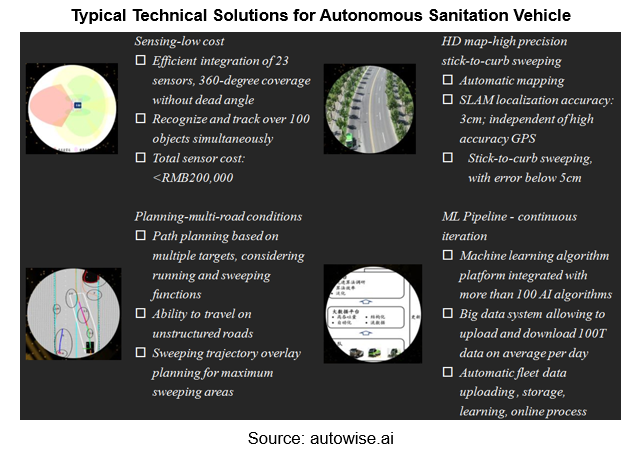
Most start-ups build autonomous sweepers based on existing sweeping vehicles, while body frame and modules of Idriverplus VIGGO are developed specially for autonomous vehicle. VIGGO’s electronic/electrical architecture consists of the following domains: Computing and Control, Powertrain, Body System, Steering System, Business System, and Information and Communication.
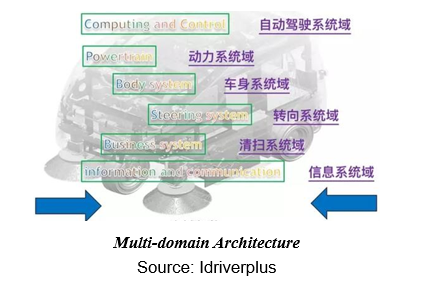
The new design that dispenses with driver’s seat saves seat space for water tank or battery to increase effective operating radius.
By virtue of down-to-earth R&D and reliable products, Idriverplus acquired orders for 1,000 units of its 5G autonomous vehicles from China Mobile in July 2019. Hundreds of VIGGO sweepers have been sold.
In February 2020, Idriverplus also rolled out a spraying sterilizer vehicle for curbing coronavirus disease.
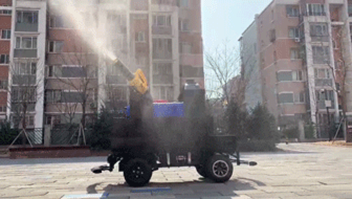
Apart from VIGGO, cockpitless design is also found in AXL, a fully autonomous concept mining truck introduced by Scania. The vehicle represents a future trend for mining vehicle.
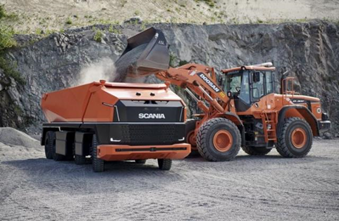
Autonomous mining vehicle
Autonomous mining vehicles already find broad application in foreign countries. Autonomous mining vehicles of Fortescue Metals Group Ltd (FMG), an iron ore tycoon, have run a total of 33.5 million km and transported more than 1 billion tons of ores and materials, with production efficiency 30% higher than conventional manual transport. FMG has operated 137 self-driving mining vehicles.
In China, mining companies need to pay out tens of billions of yuan for workers to transport ores and materials each year, who cannot still ensure transport safety and efficiency. In major mining areas of China, road dump trucks featuring non-widebody and small tonnage are largely used with ownership of roughly 200,000 units, while around 5,000 units of off-road wide body dump trucks for mining are produced and sold annually, with ownership of just over 10,000 units. The refitted autonomous mining vehicle market (OEM and aftermarket) in China is valued at least RMB500 billion.
As concerns technology roadmap, mining trucks usually utilize the LiDAR + vision + radar solution for their common price of RMB800,000 at least makes manufacturers seldom weigh the cost of LiDAR. The three sensor fusion solution allows all-day, all-weather perception by sensing system in bad conditions at mines. That mining vehicles travel at low speeds and in simple environment means that LiDAR is optional so some companies also use vision + radar solution for a sharp cut in refit cost.
Major autonomous mining truck solution providers in China have actual projects carried out but all on small scale. Most of autonomous mining truck start-ups have closed one or two funding rounds, marking that capital has turned attention to the segment. At present, they are close to each other in technology roadmap but still need to improve their technology, with orders they announced often worth RMB100 million or so and few vehicles operated (generally dozens of units), which means no one plays a leading role.
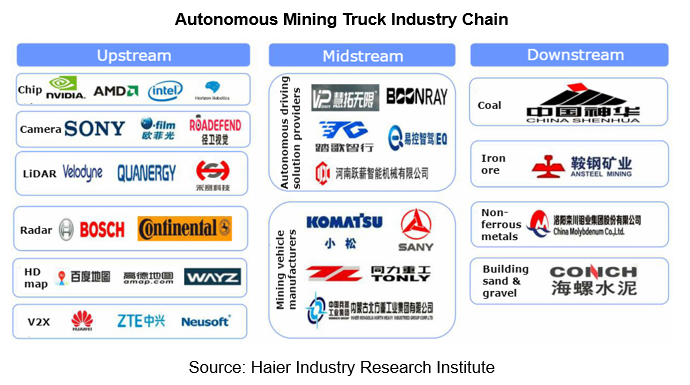
Following a contract for two new autonomous vehicles signed on July 4, 2019, Beijing Tage Idriver Technology Co., Ltd. and Inner Mongolia North Hauler Joint Stock Co., Ltd., China’s largest mining truck manufacturer sweeping 80% of the domestic market, signed on April 8, 2020 a supply order for 10 sets of “autonomous driving control systems”, which will be mounted on 10 units of new NTE200AT vehicles.
Autonomous agricultural vehicle
Autonomous driving for agricultural machinery, the simplest one among all autonomous driving technologies for special vehicles, depends more on high-precision positioning systems and software algorithms. Mainstream hardware configuration is Beidou system + angle sensor + IMU, and vision is optional and available to users who need. In terms of technology roadmap, OEMs often use a hydraulic solution where electro-hydraulic proportional valves are used to drive steering wheel. In aftermarket, the electric steering wheel solution in which motors are used to simulate manual driving is largely used due to being easy to refit and low cost.
Globally, big agricultural machinery manufacturers all have a range of models pre-installed autonomous driving technology (GPS Ready). Examples include John Deere 8R Series, Case New Holland Magnum Series, and AGCO Auto Guide 3000 with standard configuration of Danfoss hydraulic valves. In the Chinese OEM market, hydraulic solutions rule the roost.
In aftermarket, hydraulic and steering wheel autonomous driving solutions take up a considerable proportion of installation and sales. In the Chinese market, flagship products of most system providers are steering wheel solution. Beijing UniStrong Science & Technology Co., Ltd. provides both hydraulic and steering wheel solutions but the hydraulic dominate; Shanghai AllyNav Technology Co., Ltd. has offerings of both, of which the hydraulic led previously and the steering wheel got vigorously promoted in 2019. Of the shipments of autonomous driving systems for agricultural machinery in China, electric steering wheel solutions shared roughly 20% and the hydraulic solutions swept 80% from 2018 to 2019.
In view of application, agricultural machinery self-driving systems are still expensive (RMB70,000-RMB80,000/set), and massively used in areas with large farmlands, like Xinjiang and Northeastern China. Agricultural machinery autonomous driving system market in China will be valued at RMB4 billion to RMB5 billion given that virtually 200,000 units of mid- and high-end tractors are sold a year and penetration of such systems is 50%. In future, autonomous driving and variable operations will bring a larger market.
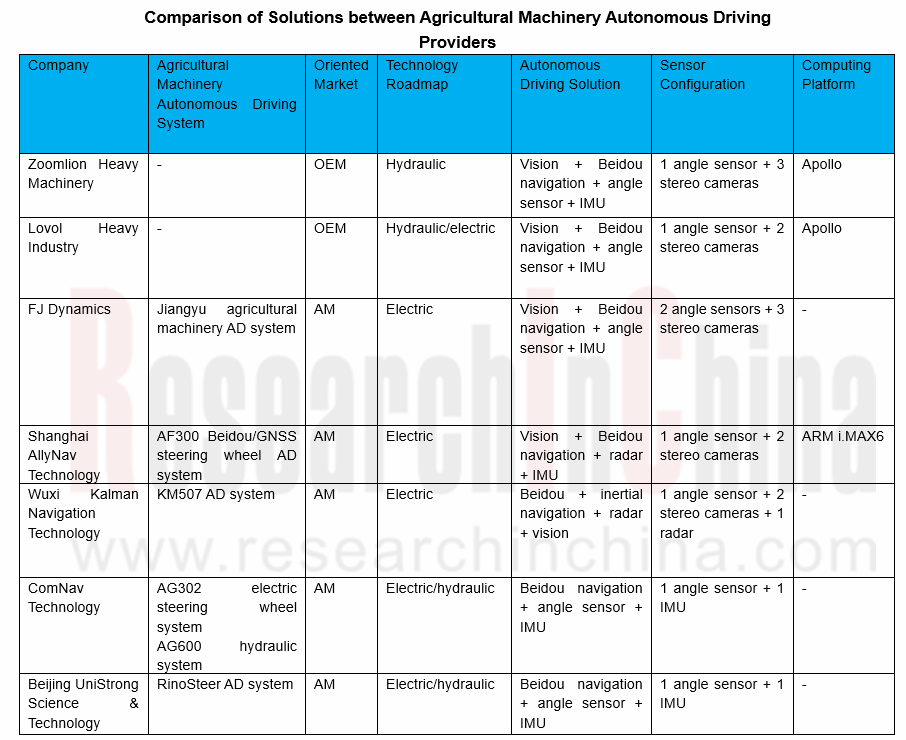
Autonomous Driving Domain Controller and Central Computing Unit (CCU) Industry Report, 2025
Research on Autonomous Driving Domain Controllers: Monthly Penetration Rate Exceeded 30% for the First Time, and 700T+ Ultrahigh-compute Domain Controller Products Are Rapidly Installed in Vehicles
L...
China Automotive Lighting and Ambient Lighting System Research Report, 2025
Automotive Lighting System Research: In 2025H1, Autonomous Driving System (ADS) Marker Lamps Saw an 11-Fold Year-on-Year Growth and the Installation Rate of Automotive LED Lighting Approached 90...
Ecological Domain and Automotive Hardware Expansion Research Report, 2025
ResearchInChina has released the Ecological Domain and Automotive Hardware Expansion Research Report, 2025, which delves into the application of various automotive extended hardware, supplier ecologic...
Automotive Seating Innovation Technology Trend Research Report, 2025
Automotive Seating Research: With Popularization of Comfort Functions, How to Properly "Stack Functions" for Seating?
This report studies the status quo of seating technologies and functions in aspe...
Research Report on Chinese Suppliers’ Overseas Layout of Intelligent Driving, 2025
Research on Overseas Layout of Intelligent Driving: There Are Multiple Challenges in Overseas Layout, and Light-Asset Cooperation with Foreign Suppliers Emerges as the Optimal Solution at Present
20...
High-Voltage Power Supply in New Energy Vehicle (BMS, BDU, Relay, Integrated Battery Box) Research Report, 2025
The high-voltage power supply system is a core component of new energy vehicles. The battery pack serves as the central energy source, with the capacity of power battery affecting the vehicle's range,...
Automotive Radio Frequency System-on-Chip (RF SoC) and Module Research Report, 2025
Automotive RF SoC Research: The Pace of Introducing "Nerve Endings" such as UWB, NTN Satellite Communication, NearLink, and WIFI into Intelligent Vehicles Quickens
RF SoC (Radio Frequency Syst...
Automotive Power Management ICs and Signal Chain Chips Industry Research Report, 2025
Analog chips are used to process continuous analog signals from the natural world, such as light, sound, electricity/magnetism, position/speed/acceleration, and temperature. They are mainly composed o...
Global and China Electronic Rearview Mirror Industry Report, 2025
Based on the installation location, electronic rearview mirrors can be divided into electronic interior rearview mirrors (i.e., streaming media rearview mirrors) and electronic exterior rearview mirro...
Intelligent Cockpit Tier 1 Supplier Research Report, 2025 (Chinese Companies)
Intelligent Cockpit Tier1 Suppliers Research: Emerging AI Cockpit Products Fuel Layout of Full-Scenario Cockpit Ecosystem
This report mainly analyzes the current layout, innovative products, and deve...
Next-generation Central and Zonal Communication Network Topology and Chip Industry Research Report, 2025
The automotive E/E architecture is evolving towards a "central computing + zonal control" architecture, where the central computing platform is responsible for high-computing-power tasks, and zonal co...
Vehicle-road-cloud Integration and C-V2X Industry Research Report, 2025
Vehicle-side C-V2X Application Scenarios: Transition from R16 to R17, Providing a Communication Base for High-level Autonomous Driving, with the C-V2X On-board Explosion Period Approaching
In 2024, t...
Intelligent Cockpit Patent Analysis Report, 2025
Patent Trend: Three Major Directions of Intelligent Cockpits in 2025
This report explores the development trends of cutting-edge intelligent cockpits from the perspective of patents. The research sco...
Smart Car Information Security (Cybersecurity and Data Security) Research Report, 2025
Research on Automotive Information Security: AI Fusion Intelligent Protection and Ecological Collaboration Ensure Cybersecurity and Data Security
At present, what are the security risks faced by inte...
New Energy Vehicle 800-1000V High-Voltage Architecture and Supply Chain Research Report, 2025
Research on 800-1000V Architecture: to be installed in over 7 million vehicles in 2030, marking the arrival of the era of full-domain high voltage and megawatt supercharging.
In 2025, the 800-1000V h...
Foreign Tier 1 ADAS Suppliers Industry Research Report 2025
Research on Overseas Tier 1 ADAS Suppliers: Three Paths for Foreign Enterprises to Transfer to NOA
Foreign Tier 1 ADAS suppliers are obviously lagging behind in the field of NOA.
In 2024, Aptiv (2.6...
VLA Large Model Applications in Automotive and Robotics Research Report, 2025
ResearchInChina releases "VLA Large Model Applications in Automotive and Robotics Research Report, 2025": The report summarizes and analyzes the technical origin, development stages, application cases...
OEMs’ Next-generation In-vehicle Infotainment (IVI) System Trends Report, 2025
ResearchInChina releases the "OEMs’ Next-generation In-vehicle Infotainment (IVI) System Trends Report, 2025", which sorts out iterative development context of mainstream automakers in terms of infota...